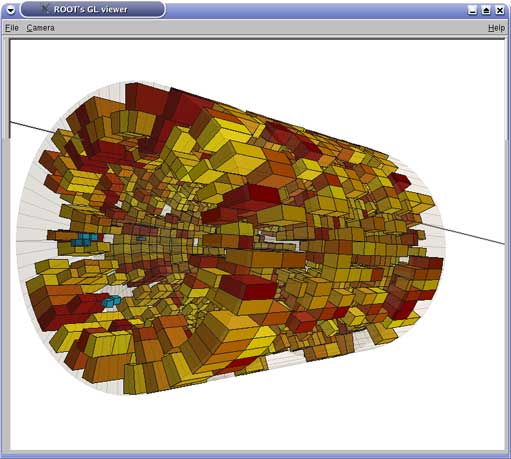
ATLAS e-News
23 February 2011
Muon and Calorimeter round-up
22 September 2008

The Tile Calorimeter records beam splash
The calorimeters and the muon chambers passed the hard exam on September 10, when the first beam circulated along the LHC, all with distinction.
Liquid Argon
Early in the morning of the turn-on day, the liquid argon (LAr) team was excited waiting for the first beam: “We were all ‘sur le pont’, eager to see events; for many people in the LAr group, collecting signal coming from the LHC is the result of many years of work,” says Isabelle Wingerter, project leader of the LAr group.
After the first beam hit the ATLAS detector, the Liquid Argon Calorimeter did not encounter any problems collecting events. During the first set of splash events, the Liquid Argon Calorimeter could see signal through the trigger chain. Although those signals were not very visible, due to a timing shift for a few cells, things got better as the day went on:
“We then got very active events in LAr later in the day, with up to 250 TeV of collected energy. The results are very encouraging as we can see that all the stages of the detector are in good shape,” Isabelle says. The LAr team is now working on both the online and offline monitoring, plus analyzing these events and tuning the calibration parameters.
With the confidence gained after the September 10 success, the LAr group is waiting for the next beam to go through the ATLAS detector and if possible, start analyzing the first collisions: “The next step for us is to detect and analyze proton-proton collisions at 900GeV, and of course, then the 10 TeV collisions,” said Isabelle in an interview on September 17.
Tile Calorimeter
“In the Tile Calorimeter, things were lived with excitement. For the first beam, the control room was packed,” says Monica Dunford, the Tile Calorimeter Run Coordinator. The calorimeter performance lived up to expectations and it was able to see the beam as it passed by. When the now famous splash event popped up on the ATLAS control room main screen, everyone was cheering: “When that event appeared, any remaining tension or apprehension just disappeared and was replaced by pure euphoria,” Monica remembers.
As the first beam produced so many muons that crossed the Tile Calorimeter, the group was able to quickly look at that data to verify the calorimeter readout timing: “By noon we already had some preliminary plots of the timing showing that our timing was really good. That made us even happier,” Monica says. “In the end, all my worrying was for nothing because the Tile Calorimeter worked just perfectly.”
Of course, it all went smoothly only because of all the hard work the Tile group put in during the weeks and months before the turn-on day. During that time in which all the critical issues allowing the calorimeter to take on the beam without any problems had been solved.
After that successful test, the list of things-to-do for the Tile Calorimeter is all about refining details of its operation. Some of those tasks are getting the readout timing to the level of a few nanoseconds and verifying that the calibration constants are correct: “We are ready for collisions so that is the next step that we can't wait to see,” says Monica.
Muon chambers
The outermost part of the ATLAS detector, the muon chambers, also performed at the highest level during the LHC turn-on day: “That Wednesday was a very exciting day. For the first time, we were able to see tracks in all our detectors. We've been waiting for this moment for decades!” says Sotiris Vlachos the muon group Run Coordinator.
“Later in the day we started to realize that it was only the beginning of the long journey in front of us,” he adds.
It was very fortunate, Sotiris explains, that the first beam to go through ATLAS was set up to hit the last collimator right before the detector: “Because of that, thousands of particles were produced and went through ATLAS,” says Sotiris. “The various muon detectors actually saw all these particles, as is shown on the now famous picture of the first ATLAS event.”
“This event shows many hundred of thousands of tracks going through the muon detectors. Approximately one third of all our detector channels were hit! This was a really big exciting event.”
As for the calorimeters, no major problems tarnished the day for the muon system when the beam made its appearance. But as Sotiris points out: “It was a success because all experts were around making sure all subsystems were fully operational for several days before start-up. It takes a long time and continuous effort to be able to say 'no particular problem at a given time' ”
Now, as the rest of the ATLAS sub-systems, the muon group is eagerly waiting for the first collisions and to see particles accelerated at TeV energies.

Cristina JimenezATLAS e-News |